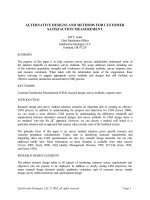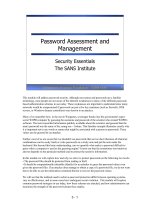access, assessment and engagement for all
Bạn đang xem bản rút gọn của tài liệu. Xem và tải ngay bản đầy đủ của tài liệu tại đây (1.19 MB, 40 trang )
Universal Design for Learning:
Access, Assessment & Engagement for All
Jolene Troia
Education Consultant
Wisconsin Department of Public Instruction
608-266-5583
Education is in a state of CHANGE!
Why do we need to make changes?
•
Increasing diversity in classrooms
•
Adoption of Common Core State Standards and Common
Core Essential Elements
•
New Educator Effectiveness system
•
Emphasis on high quality instruction, collaboration,
balanced assessment, and culturally responsive practices
•
Increased emphasis on data
•
Traditional methods are not working for ALL students
•
Fewer than 11% of students with intellectual
disabilities are fully included in regular
education classrooms (Smith & O’Brien, 2007)
–
Many of these students simply haven’t been given
the chance to try
•
“Among the chief
obstacles faced by
people with
intellectual
disabilities are the
limiting expectations
that others have for
them.”
–
Thomas Armstrong,
Neurodiversity in The
Classroom
The way we learn is as unique as our
fingerprints
Brain Imaging Showing Individual Differences
3 different people learning the same finger tapping task
Universal Design for Learning
Is
what?
Is
what?
A scientifically valid framework
that
Provides multiple means of access,
assessment, and engagement and
removes barriers in instruction
Does
what?
Does
what?
to
achieve academic and
behavioral success
for all
For
what?
For
what?
•
Reduces barriers
•
Meets the wide range of needs of all learners
•
One size fits all approach is not effective
•
Inspired from universal design in architecture
Universal Design for Learning
Closed Captioning
Barriers
Diving into the UDL Framework
Components of the UDL Framework
ACCESS ASSESSMENT ENGAGEMENT
Adapted from CAST
Three UDL Principles
Access Assessment Engagement
Provide Multiple Means
of Representation
Provide Multiple Means
of Action and Express
ion
Provide Multiple Mean
s of Engagement
Resources to Explore
the UDL Framework
Website App Wheel Wiki
www.udlcenter.org/aboutudl/
udlguidelines/principle1
onlinegrants.org/
i
spaces.com/
Already doing UDL?
A Look at UDL Principles & Practice
UDL Starts with Student Strengths
Strengths of Individuals with Cognitive Disabilities
•
You have to KNOW your students and
collaborate with the general education
teacher to capitalize on these strengths
•
Individual for each child but there are some
general strengths that can be found in various
disabilities
Strengths of Students with Down Syndrome
•
excellent imitation skills
•
good sense of humor
•
strong visual-motor skills
•
well developed non-verbal social skills
•
very friendly
from Neurodiversity in the Classroom by Thomas Armstrong
Strengths of Students with Williams Syndrome
•
strong musical abilities
•
good oral expression skills
•
enjoy being with other people
•
strong understanding of the emotional state
of others and facial cues
•
good auditory memory
from Neurodiversity in the Classroom by Thomas Armstrong
Strengths of Students with Fragile X Syndrome
•
excellent memory
•
great sense of humor
•
good imitation skills
•
strong empathy for others
from Neurodiversity in the Classroom by Thomas Armstrong
Strengths of Students with Prader-Willi Syndrome
•
enjoy reading
•
good at jigsaw and word search puzzles
•
long term memory
•
nurturing
from Neurodiversity in the Classroom by Thomas Armstrong









